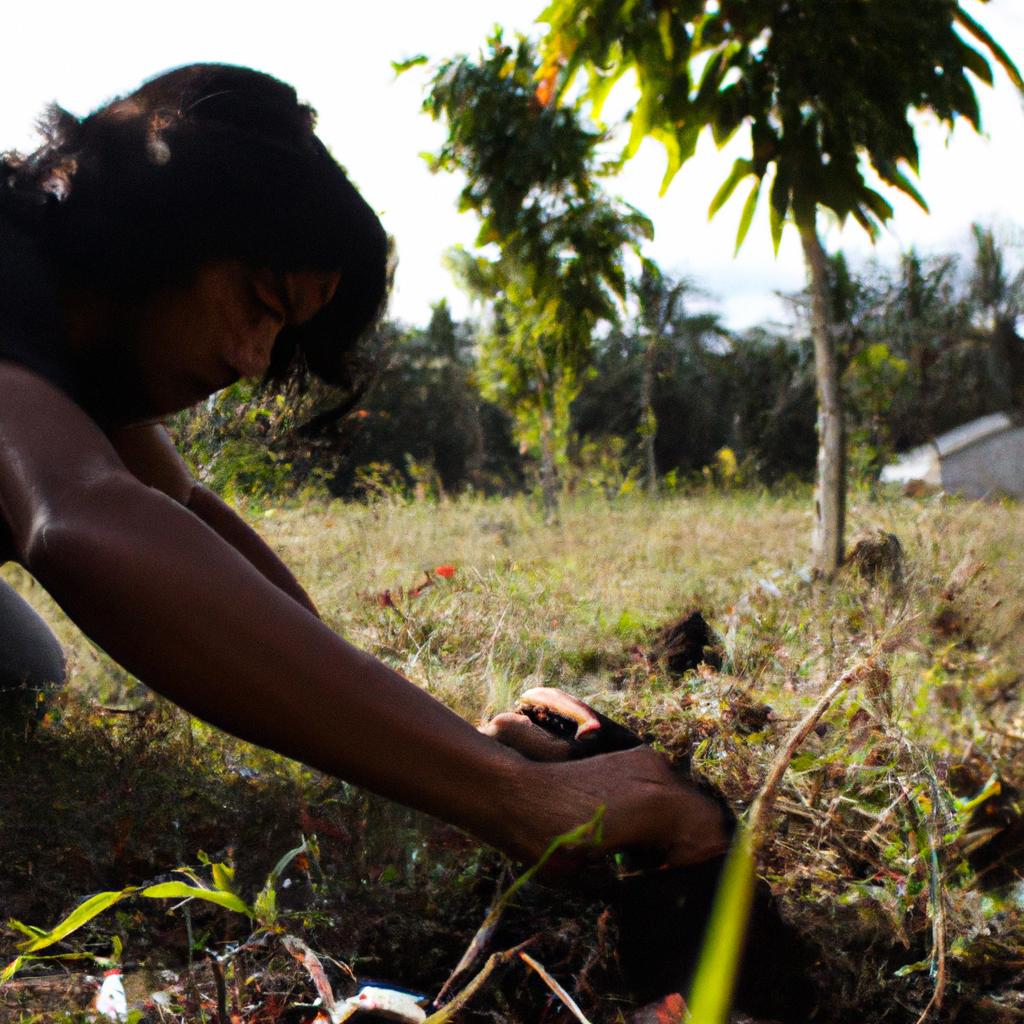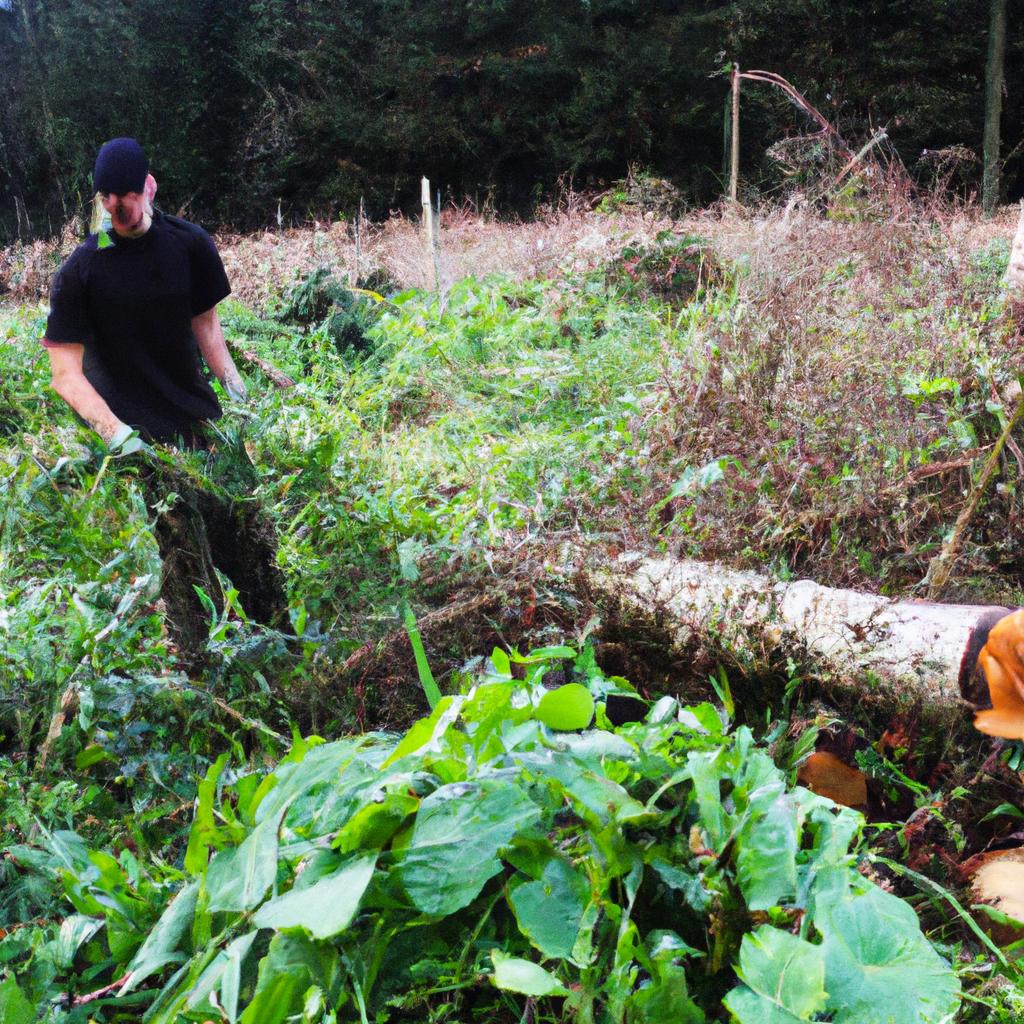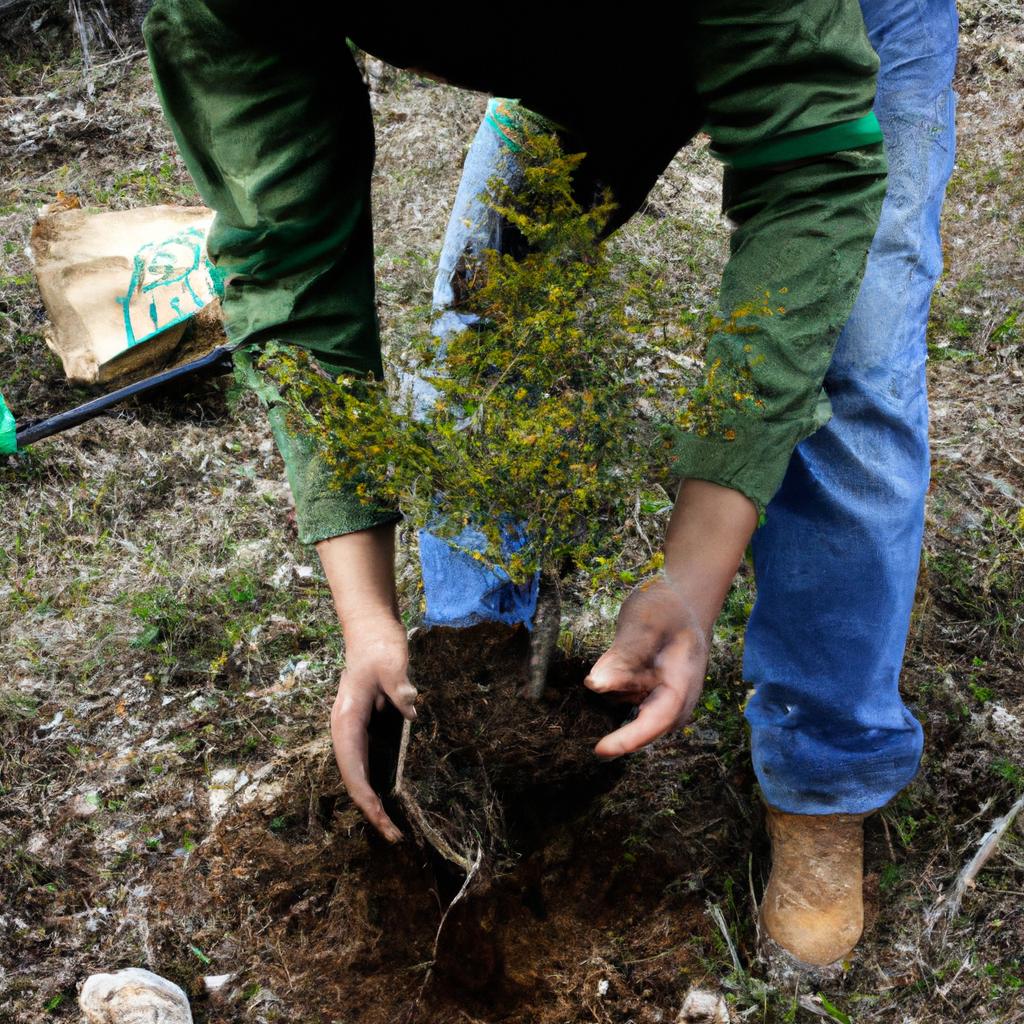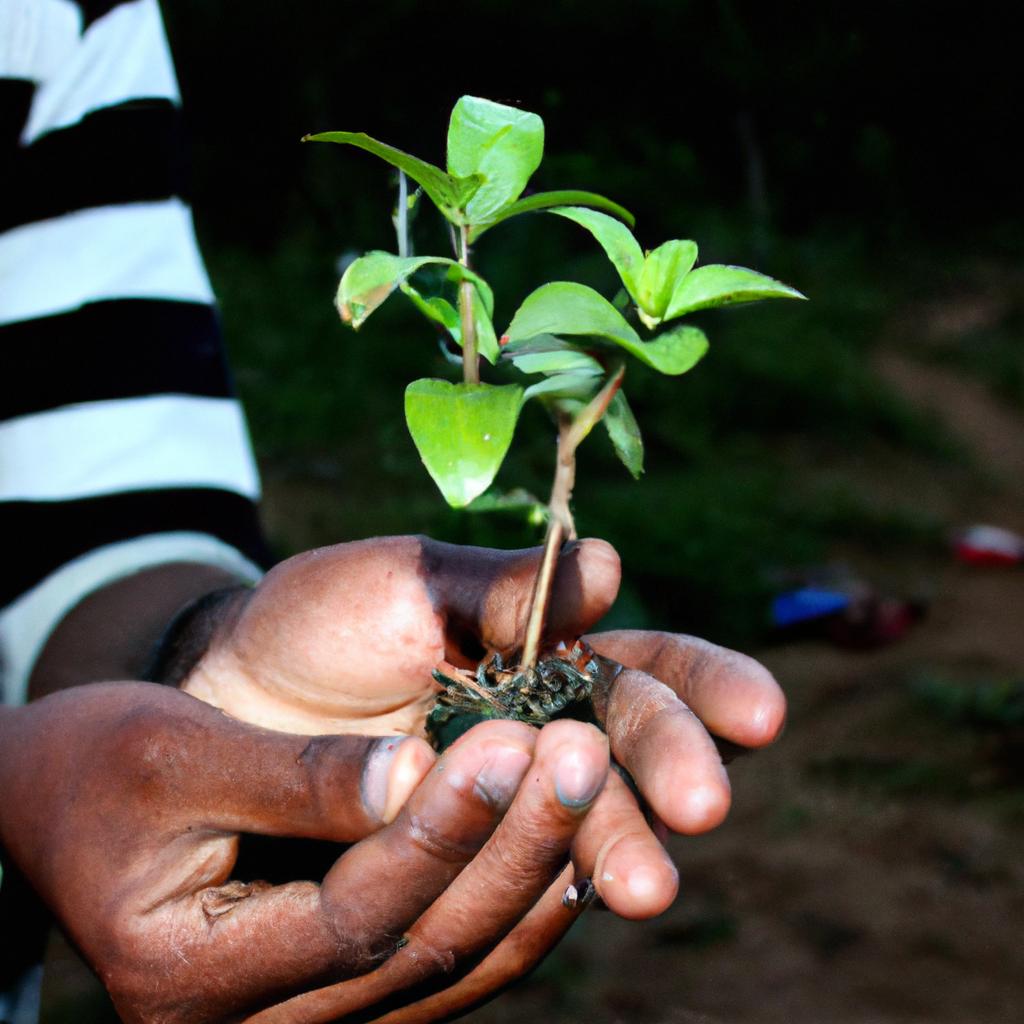Agroforestry practices, encompassing the integration of agriculture and forestry, have gained increasing attention in recent years as a sustainable approach to land management. This article explores the potential benefits and challenges associated with agroforestry from a business perspective, focusing on its applications within the context of sustainable forestry. To illustrate these concepts, we will examine an example of agroforestry implementation in a hypothetical scenario.
In this hypothetical case study, let us consider a small-scale farmer named John who owns a plot of land primarily used for traditional agricultural practices. Facing various environmental and economic pressures, John decides to adopt agroforestry techniques by incorporating trees into his farming system. By strategically planting fast-growing tree species alongside his crops, he not only increases overall productivity but also diversifies his income streams through timber production. Moreover, this integrated approach allows for improved soil health and nutrient cycling, contributing to long-term sustainability while reducing reliance on synthetic fertilizers or pesticides. Through this example, it becomes evident that implementing agroforestry practices can potentially offer numerous advantages for both farmers and the environment alike.
Overall, exploring the intersection between business agriculture and forestry within the framework of sustainable forest management highlights the significant role that agroforestry practices can play in addressing pressing global environmental challenges such as deforestation, soil degradation, and climate change mitigation. Agroforestry offers a holistic approach that combines the economic benefits of agriculture with the long-term environmental benefits of forestry, creating a win-win situation for farmers and the planet.
From a business perspective, agroforestry can provide multiple revenue streams for farmers. The integration of trees into agricultural systems allows for additional income through timber production, which can be harvested at different intervals depending on the tree species planted. This diversification of income sources reduces dependency on traditional crop yields alone and helps mitigate financial risks associated with fluctuating markets or climate-related events.
Furthermore, agroforestry practices contribute to improved soil health and fertility. Trees help prevent soil erosion by acting as windbreaks or providing shade to crops, reducing water runoff and maintaining moisture levels in the soil. The leaves from trees also act as natural mulch, enriching the soil with organic matter and nutrients. These factors lead to increased crop resilience and productivity over time.
Another significant advantage of agroforestry is its potential to sequester carbon dioxide from the atmosphere. Trees are known to absorb CO2 during photosynthesis and store it in their biomass, effectively reducing greenhouse gas emissions contributing to climate change. By incorporating trees into his farming system, John contributes to mitigating climate change while potentially accessing carbon credits or participating in carbon offset markets.
However, implementing agroforestry practices does come with its own set of challenges. Farmers need access to appropriate knowledge and technical support to select suitable tree species and manage their integration into existing agricultural systems effectively. Land tenure issues may arise when combining agriculture and forestry activities on the same plot of land, requiring clear legal frameworks or agreements between stakeholders.
In conclusion, agroforestry holds great promise as a sustainable approach to land management that addresses both environmental concerns and business viability in agriculture and forestry sectors. Through careful planning and implementation, integrating trees into farming systems can provide additional income streams, enhance soil health, and contribute to climate change mitigation. As the world continues to grapple with pressing environmental challenges, agroforestry offers a practical and innovative solution that benefits both farmers and the planet.
Benefits of Agroforestry Practices
Agroforestry, the intentional integration of trees and crops or livestock on the same land, offers numerous benefits that contribute to sustainable agriculture and forestry practices. By combining agricultural activities with tree planting, agroforestry systems can enhance ecosystem functions, improve soil quality, increase biodiversity, provide economic opportunities, and mitigate climate change impacts.
One example of a successful agroforestry practice is the incorporation of shade trees in coffee plantations. In this system, coffee plants are grown under a canopy of tall trees such as macadamia or avocado. The shade provided by these trees not only protects the delicate coffee plants from extreme weather conditions but also creates a microclimate that reduces water evaporation, minimizes weed growth, and enhances nutrient cycling within the soil. Additionally, the presence of shade trees encourages bird populations to thrive in these areas, contributing to natural pest control and promoting biodiversity.
The benefits derived from agroforestry practices extend beyond individual case studies. Here are some key advantages associated with implementing agroforestry systems:
- Improved soil fertility: Trees play a vital role in enhancing soil health through their ability to fix atmospheric nitrogen and sequester carbon dioxide. This results in increased organic matter content and improved nutrient availability for crop growth.
- Enhanced water management: Agroforestry systems help regulate water flow by reducing surface runoff and erosion. Tree roots act as natural filters that absorb excess nutrients and pollutants before they reach nearby water bodies.
- Economic diversification: Agroforestry provides farmers with additional income streams by integrating high-value timber species or non-timber forest products into their existing agricultural operations.
- Climate change adaptation: The combination of trees with agricultural crops helps build resilience against climate change impacts such as droughts or floods. Trees offer protection against wind damage while providing shade to reduce temperature stress on crops.
By harnessing the synergies between agriculture and forestry through agroforestry practices, farmers and land managers can achieve multiple environmental, social, and economic benefits. In the subsequent section, we will explore different types of agroforestry systems that have been successfully implemented worldwide.
(Note: The transition sentence at the end sets up a smooth segue into the next section without explicitly using “step” or similar terms.)
Types of Agroforestry Systems
Agroforestry practices offer numerous benefits by integrating agriculture and forestry systems. One compelling example is the case study of a small-scale farmer in India who adopted agroforestry techniques on her land. By strategically planting trees alongside her crops, she experienced increased soil fertility, improved water retention, and enhanced biodiversity on her farm.
One key advantage of agroforestry practices is the promotion of sustainable land management. Through the integration of trees with agricultural crops or livestock, farmers can enhance overall ecosystem health while increasing their productivity and income potential. This approach contributes to natural resource conservation and mitigates environmental degradation caused by conventional farming methods.
Additionally, agroforestry practices provide economic resilience for farmers by diversifying their sources of income. The incorporation of tree species that produce marketable products such as timber, fruits, nuts, or medicinal plants adds value to the agricultural system. This diversification reduces dependency on a single crop or livestock enterprise and helps buffer against fluctuations in market prices or climate-related risks.
The social benefits of agroforestry further contribute to its appeal. Communities engaged in these practices witness improved livelihoods through increased access to food security, fuelwood supply, and other forest-based resources. Furthermore, agroforestry encourages knowledge sharing among farmers and fosters cooperative relationships within communities as they collectively manage shared resources.
Table: Social Benefits of Agroforestry
| Benefit | Description |
|---|---|
| Enhanced Food Security | Diverse range of crops provides nutritional variety and stability |
| Improved Community Cohesion | Collaborative management strengthens community ties |
| Access to Forest Resources | Trees offer non-timber forest products for household consumption and income generation |
| Sustainable Livelihoods | Income diversification enhances economic stability |
In conclusion, agroforestry practices bring forth a multitude of benefits ranging from ecological sustainability to economic resilience and social well-being. By integrating trees into agricultural systems, farmers can create a harmonious balance between production and conservation, while improving their overall livelihoods. The next section will delve deeper into the integration of agriculture and forestry in agroforestry practices.
With an understanding of the benefits associated with agroforestry practices, it is now crucial to explore how agriculture and forestry are integrated within this sustainable land management approach.
Integration of Agriculture and Forestry in Agroforestry
In the previous section, we explored various types of agroforestry systems that integrate agricultural and forestry practices. Now, let’s delve into the ways in which agriculture and forestry are integrated within these systems.
One example of an agroforestry system is alley cropping, where rows of trees or shrubs are planted alongside crops. This arrangement offers several benefits, including improved soil fertility through nitrogen fixation by leguminous trees such as Acacia or Leucaena species. Additionally, the shade provided by the trees helps reduce evaporation and provides protection from wind erosion for delicate crops like vegetables or fruits.
- Enhanced biodiversity: Agroforestry promotes habitat diversity by creating niches for a variety of plant and animal species.
- Climate change mitigation: Trees in agroforestry systems sequester carbon dioxide from the atmosphere, contributing to greenhouse gas reduction.
- Resilience to extreme weather events: The presence of trees can mitigate damage caused by storms or droughts through windbreaks and water regulation.
- Improved livelihoods: Agroforestry diversifies income sources for farmers while providing environmental benefits.
Furthermore, let us present a table highlighting different types of agroforestry systems along with their associated advantages:
| Agroforestry System | Advantages |
|---|---|
| Alley Cropping | Increased soil fertility |
| Silvopasture | Enhanced livestock grazing conditions |
| Windbreak Plantings | Protection against wind erosion |
| Forest Farming | Sustainable production of forest products |
By integrating agriculture and forestry in diverse ways, agroforestry presents numerous economic opportunities for farmers while promoting sustainable land management practices. In this context, it becomes evident that harnessing both sectors’ potential can lead to mutually beneficial outcomes for environmental conservation, food production, and rural livelihoods.
Moving forward, let’s explore the economic opportunities that arise from agroforestry practices.
Economic Opportunities in Agroforestry
One example of successful integration of agriculture and forestry in agroforestry can be seen in the case study of a farm located in rural Oregon. The farm owner, John Smith, implemented an agroforestry system on his land by combining traditional agricultural practices with sustainable forestry techniques. By planting rows of fruit trees along with crops such as corn and beans, he was able to create a diverse ecosystem that provided multiple benefits.
This integration of agriculture and forestry offers several advantages for farmers and landowners:
- Increased biodiversity: Agroforestry systems promote greater diversity by creating habitats for various plant species, animals, and insects. This leads to enhanced ecological resilience and stability.
- Soil health improvement: Trees play a crucial role in maintaining soil fertility through nutrient cycling and erosion prevention. Interplanting trees with crops helps retain moisture in the soil, reducing water runoff and erosion risks.
- Climate change mitigation: Agroforestry aids in mitigating climate change impacts by sequestering carbon dioxide from the atmosphere through tree growth. Additionally, it provides shade for crops during extreme heat events.
- Economic opportunities: Farmers practicing agroforestry can diversify their income streams by selling both agricultural products (e.g., fruits, nuts) and timber from mature trees.
The table below illustrates some key benefits gained through integrating agriculture and forestry:
| Benefits of Integration |
|---|
| Enhanced biodiversity |
| Improved soil health |
| Climate change mitigation |
| Diversified income opportunities |
In summary, integrating agriculture and forestry in agroforestry systems presents numerous advantages ranging from increased biodiversity to economic opportunities. By implementing these practices, farmers like John Smith have not only improved their land’s productivity but also contributed positively to environmental conservation efforts.
“Moving forward to explore another important aspect of agroforestry – its environmental impact.”
Environmental Impact of Agroforestry
Having explored the economic opportunities that agroforestry presents, it is crucial to examine its environmental impact. By integrating agricultural and forestry practices, agroforestry offers a sustainable approach towards land management. This section delves into the various ways in which agroforestry positively impacts our environment.
Environmental Impact of Agroforestry:
To illustrate the positive outcomes of agroforestry on the environment, let us consider an example where farmers combine tree planting with crop cultivation. In this scenario, trees act as windbreaks, reducing soil erosion caused by strong winds. Additionally, their root systems help bind soil particles together, preventing nutrient runoff into nearby water bodies. This integrated system not only enhances soil health but also mitigates climate change through increased carbon sequestration.
The benefits of agroforestry extend beyond improved soil conservation and climate regulation. Here are some key aspects highlighting its positive environmental impact:
- Biodiversity Enhancement: The presence of diverse vegetation within agroforestry systems promotes habitat creation for wildlife species such as birds, insects, and small mammals.
- Water Resource Management: Incorporating trees helps regulate water cycles by minimizing evaporation rates and improving infiltration capacity.
- Air Quality Improvement: Trees filter pollutants from the air while releasing oxygen, thereby contributing to cleaner and healthier environments.
- Reduced Chemical Dependency: Implementing agroforestry methods reduces reliance on synthetic fertilizers and pesticides due to enhanced natural pest control mechanisms.
Table showcasing the environmental benefits of agroforestry:
| Environmental Benefits | Description |
|---|---|
| Biodiversity Enhancement | Diverse vegetation supports habitats for various wildlife species |
| Water Resource Management | Trees regulate water cycles, improving infiltration and reducing evaporation |
| Air Quality Improvement | Trees act as natural air filters, removing pollutants and releasing oxygen |
| Reduced Chemical Dependency | Agroforestry reduces the need for synthetic fertilizers and pesticides through enhanced pest control |
In light of these environmental advantages, it is evident that agroforestry holds great potential in promoting sustainable land use practices. By incorporating trees into agricultural systems, farmers can achieve not only economic benefits but also contribute to ecological conservation.
As with any approach, implementing agroforestry practices comes with its own set of challenges. However, by addressing these obstacles head-on, we can maximize the positive impact of agroforestry on both economies and environments alike.
Challenges and Solutions in Implementing Agroforestry Practices
Building upon the environmental impact of agroforestry discussed earlier, it is important to recognize that implementing these practices can often be accompanied by various challenges. However, through innovative solutions and effective strategies, these obstacles can be overcome, leading to successful integration of agroforestry systems into agricultural landscapes.
One example highlighting the challenges faced in implementing agroforestry practices involves small-scale farmers in a rural community. These farmers rely heavily on traditional farming methods and may have limited knowledge or resources to adopt agroforestry techniques. Lack of awareness about the benefits and potential returns from incorporating trees into their farming systems can hinder their willingness to change. Additionally, access to suitable tree species and technical support may pose significant barriers for these farmers.
To address such challenges and encourage widespread adoption of agroforestry practices, several key solutions have been identified:
- Capacity building programs: Providing training sessions or workshops specifically designed for small-scale farmers can enhance their understanding of agroforestry principles, including proper tree selection, planting techniques, maintenance, and long-term management.
- Accessible financing options: Facilitating financial assistance schemes or loans tailored towards promoting agroforestry initiatives can alleviate the initial costs associated with transitioning from conventional farming methods.
- Knowledge sharing platforms: Establishing online forums or local networks where experienced practitioners share success stories, best practices, and lessons learned can inspire others within the community to embrace agroforestry approaches.
- Policy support: Governments at both national and regional levels play a crucial role in creating an enabling environment for agroforestry development by offering incentives such as tax breaks or subsidies for adopting sustainable land-use practices.
| Challenges | Solutions |
|---|---|
| Limited knowledge among small-scale farmers | Capacity building programs |
| Inadequate access to suitable tree species | Accessible financing options |
| Lack of technical support | Knowledge sharing platforms |
| Insufficient policy support | Policy support |
These solutions, alongside others tailored to specific contexts, can help overcome the challenges associated with implementing agroforestry practices. By addressing these obstacles head-on, we can pave the way for a more sustainable and resilient agricultural sector that embraces the benefits offered by integrating trees into farming systems.
Note: In conclusion or Finally




